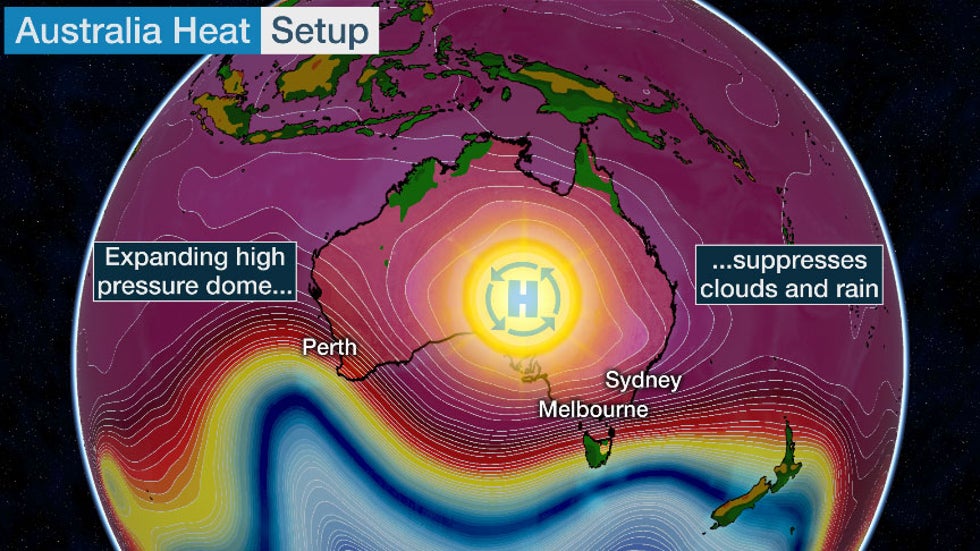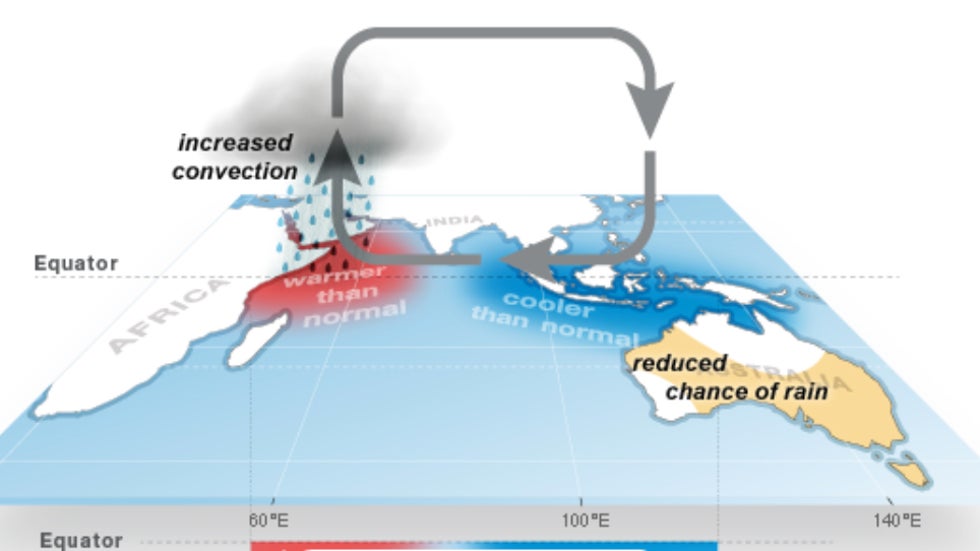A blistering heat wave will build across central and southern Australia through the week ahead, threatening all-time national heat records, and continuing what has been a hot, dry spring.
Extreme heat has already seared parts of Western Australia in the past few days.
Friday's high soared to 40.1 degrees Celsius (104 degrees Fahrenheit) in Perth, the second time this month Australia's fourth-largest city recorded a 40-plus-degree Celsius high. According to the Australian Bureau of Meteorology (BOM), only eight other years had two December days that hot.
That's only an appetizer of what's to come.
A massive dome of high pressure aloft is forecast to expand across Australia over the next several days.
This heat dome will suppress clouds and rain across much of the continent.

Given Australia is coming off its record-driest spring, the sun's energy will go directly to heating the air above the dry ground and vegetation, rather than evaporating moisture.
As a result, excessive heat will build eastward from parts of Western Australia early in the week ahead across South Australia, the southern Northern Territory and into southern Queensland, New South Wales, Victoria and Tasmania later in the week.
The Australian BOM forecasted "extreme heat wave" conditions, its highest level of heat wave severity, through late in the week, potentially including cities such as Adelaide and the nation's capital, Canberra.
Needless to say, this is not good news for the effort to battle existing bushfires across the continent.
One bushfire, which started Wednesday north of Perth, prompted an emergency warning Saturday for coastal towns, urging residents to take immediate action.
Bushfires in New South Wales have sent a pall of choking smoke into Sydney in recent days.
Records in Jeopardy
Many inland areas of southern Australia are likely to have highs soar well over 40 degrees Celsius for multiple days.
That's impressive enough.
The hottest areas of inland southern Australia, however, could have highs approaching the all-time national record high of 50.7 degrees Celsius (123.3 degrees Fahrenheit) set in Oodnadatta, South Australia, on Jan. 2, 1960.
If this doesn't set the all-time record, it could still threaten Australia's hottest December temperature record of 49.5 degrees Celsius (121.1 degrees Fahrenheit) set at the Birdsville Police Station in Queensland on Christmas Eve 1972.
BOM meteorologist Diana Eadie told the Australia Broadcasting Corporation the country could shatter its hottest single day on record, when combining all high temperatures across the country on a given day.
"It looks like we could break that record over a number of consecutive days toward the end of next week," Eadie told the ABC.
One of Australia's Hottest Years
According to the BOM, 2019 is likely to be among the four warmest years on record in Australia, in records dating to 1910.
Twenty-nine Australian locations have already set new all-time record highs in 2019, including South Australia's capital, Adelaide, which soared to 47.7 degrees Celsius (117.9 degrees Fahrenheit) on January 24, according to international records expert Maxmiliano Herrera.
The BOM also expects 2019 to be among the 10 driest years on record there.
One instigator of this hot, dry pattern is the Indian Ocean Dipole (IOD), a phenomenon of warmer and cooler than average water sloshing, similar to El Niño but over the Indian Ocean instead of the Pacific.
In October, the IOD spiked to its most positive value since 1997, according to Dr. Michael Ventrice, an atmospheric scientist at The Weather Company, an IBM Business.
When the IOD is in its positive phase, warmer than average water pools in the western Indian Ocean, near the Horn of Africa, leading to increased rain in eastern Africa and more tropical cyclone activity in the western Indian Ocean. Conversely, cooler than average water near Indonesia and off the coast of northern Australia leads to less rainfall in southern and central Australia.

The positive IOD has retreated in recent weeks but remains strongly positive. The BOM's summer outlook suggests the positive IOD may linger into January, and the typical summer rains with the northern monsoon may also arrive late.
Indeed, another long, hot, dry summer may loom for Australia.
The Weather Company’s primary journalistic mission is to report on breaking weather news, the environment and the importance of science to our lives. This story does not necessarily represent the position of our parent company, IBM.
The Weather Company’s primary journalistic mission is to report on breaking weather news, the environment and the importance of science to our lives. This story does not necessarily represent the position of our parent company, IBM.

No comments:
Post a Comment